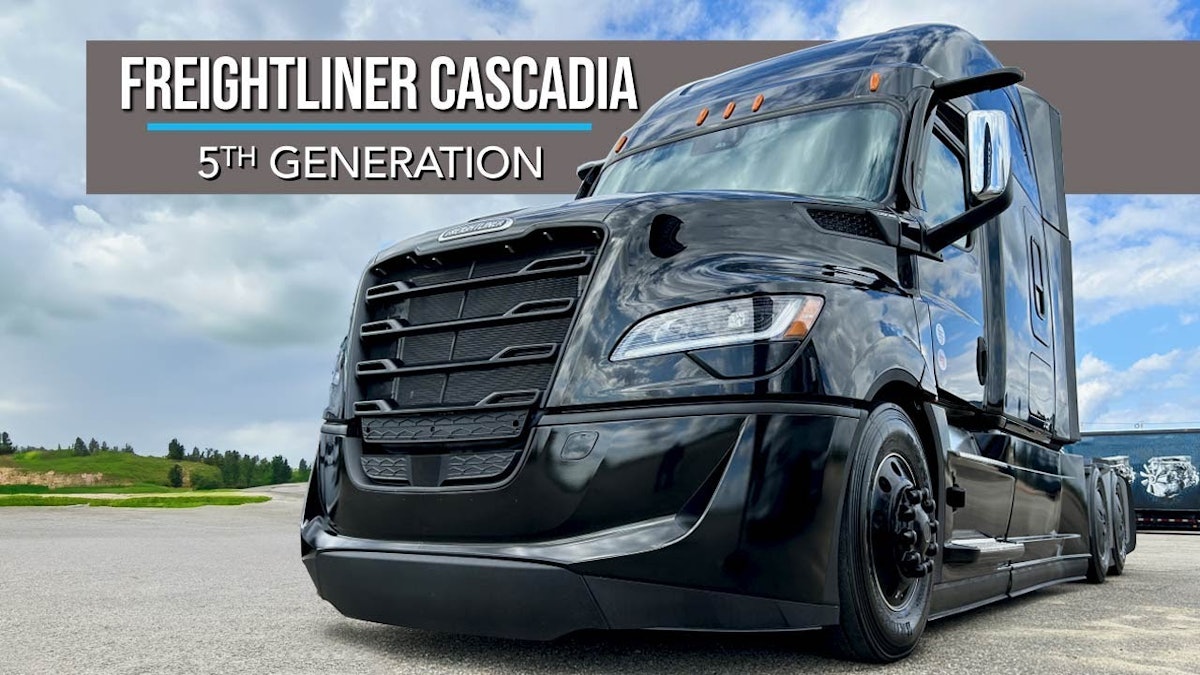
CCJ Editor Jason Cannon here. Join me for a quick look at Freightliner’s fifth generation Cascadia; a truck that will debut next year with a lot of new and more capable technology features.
Since its 2007 debut, Freightliner has retailed more than 1 million of its market-leading Cascadia on-highway tractor.
Cascadia got its first update in 2012 with the debut of the super fuel-efficient Evolution & DT12 automated manual transmission. The DT 12 is currently the gearbox of choice in about 90% of all Cascadia builds.
In 2017 came major exterior and interior changes.
Just two years later, Freightliner added lateral and longitudinal steering controls and lane assist.
For the fifth generation, which will begin production mid-2025, Freightliner focused on three tent poles: safety, efficiency and profitability.
For safety, Active Brake Assist 6 (ABA6) is now capable of seeing longer and wider and is able to recognize additional scenarios – like vehicles stopped at odd angles, vehicles in curves, stopped vehicles across multiple lanes, and it now recognizes both moving and stationary pedestrians in its path – thanks to an all new long range radar, four short range sensors, and a camera tucked at the top of the windshield.
Active Lane Assist 2 (ALA2), in addition to previous capabilities, now features Lane Change Assist, which can help mitigate lane departure accidents by providing counter steer if the truck attempts to enter an occupied lane.
Side Guard Assist 2 (SGA2) is now capable of detecting and warning drivers of objects on the driver side as well as the passenger side of the vehicle, from the cab to the end of the trailer.
The Gen5 Cascadia will also offer a factory-fit MirrorCam System with cameras mounted above the doors providing a wide field of view alongside the rig and in the look-down blindspot, and feeding those visuals to the driver through three in-cab displays. Side Guard Assist alerts also cycle into the monitors.
New dual-stage LED headlamps are 30% brighter than current generation LEDs. The lamps feature automatic deicing and defogging capabilities and auto bright and dim.
On efficiency, Cascadia has achieved fuel efficiency gains of more than 35% since the model’s first introduction 17 years ago, and aerodynamic improvements for the fifth generation add another 1.9%.
Outside the fifth generation tractor you’ll notice a new hood and grille design, a redesigned A-pillar deflector, three-piece front wheel well closeouts, a hood-to-bumper seal, and new bumper air ducts.
The air ducts in the two-piece bumper guide air around the truck and out through the wheel well. Wheel well closeouts have been added to the hood.
Originally introduced on the current Cascadia, a A-pillar deflector was intended to reduce soiling of the window and mirrors but they have now been extended to cover more of the door profile and it flairs out at the bottom to improve aerodynamics.
Available at launch will be the Detroit DD13 and DD15 engines, with ratings of up to 505 horsepower and 1,850 lb-ft of torque. Roughly 95% of all new Cascadia are currently spec’d with Detroit engines, and about 90% of them get a DT12 transmission.
The Cummins X15 diesel will also be available in 2025. The Cummins X15N natural gas engine will be available for Cascadia built in 2026. Cummins power comes in ratings of 400 to 605 hp and 1,450 to 2,050 lb-ft of torque. An EPA’27 compliant DD15 will be made available for the 2027 model year.
Not to be left out is profitability: the thing that pays all the bills.
Back office personnel also reap benefits from the updated Cascadia, primarily in improving uptime and improved operational insights through the newest connected telematics platform powering Detroit Connect.
Detroit Connect Video Capture 2.0 automatically records and captures data during safety events or when initiated by a driver, providing fleet managers with remote access to valuable insights on driver behavior and potential risks.
Remote Lock and Unlock is a new feature derived directly from fleet manager feedback and brings the ability to lock and unlock vehicles on demand, reducing roadside assistance costs.
Geofencing allows fleets to create custom-defined geographic areas in the Detroit Connect Portal and receive notifications when vehicles enter or leave that area.
Detroit Connect Safety Plus is a subscription service that allows fleet managers to remotely track and receive notifications about the status and health of Detroit Assurance safety systems.
Premium Remote Parameter Updates expands the number of parameters available for update over the air from seven to more than 50.